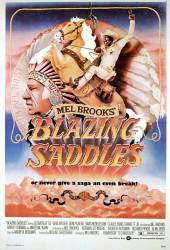Visible crew/equipment: In the Rock Ridge church scene before the dynamite bundle is thrown through the church window, the device used to break the glass is visible.
Visible crew/equipment: When Bart enters the saloon to deliver the candygram to Mongo, his shadow can clearly be seen against the painted backdrop behind him depicting the street scene. (00:47:45)
Visible crew/equipment: In the beginning when the two black workers are using the handcart to look for quicksand, you can see the cable pulling them in one quick shot.






Chosen answer: The opening line of the song refers to the Camptown Ladies and the phrase "Camptown Races" never appears anywhere in the lyrics. If nobody told him otherwise, Lyle may simply have assumed that some variation on "Camptown Ladies" was the actual title.
Tailkinker ★
The actual title of the song was "Gwine to Run All Night, or De Camptown Races," written by American lyricist Stephen Foster and first published in 1850. Over many years on the minstrel show circuit, the title was shortened to "Camptown Races" and was sometimes erroneously called "Camptown Ladies." While the phrase "Camptown Races" doesn't appear in the lyrics, the phrase "Camptown Racetrack" does appear in the second line: "Camptown ladies sing dis song, doo-dah, doo-dah, Camptown Racetrack five miles long, oh-de-doo-dah-day." The song refers to Camptown, Pennsylvania, a real town with a popular horserace in the mid-1800s.
Charles Austin Miller